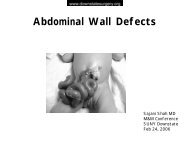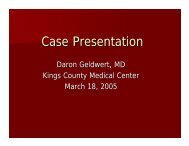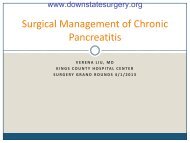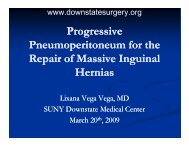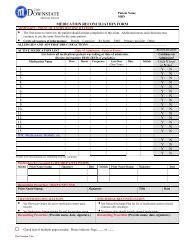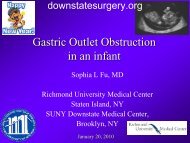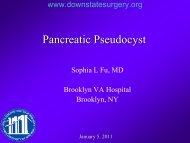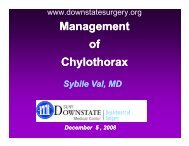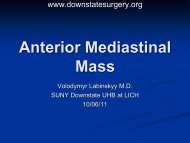Testicular Torsion - Department of Surgery at SUNY Downstate ...
Testicular Torsion - Department of Surgery at SUNY Downstate ...
Testicular Torsion - Department of Surgery at SUNY Downstate ...
- No tags were found...
You also want an ePaper? Increase the reach of your titles
YUMPU automatically turns print PDFs into web optimized ePapers that Google loves.
www.downs<strong>at</strong>esurgery.org<strong>Testicular</strong> <strong>Torsion</strong>Chief Resident Grand Rounds<strong>SUNY</strong> Downst<strong>at</strong>e Medical CenterJacob Eisdorfer, DOFebruary, 23 th 2012Thank You Dr. McNeil!
www.downs<strong>at</strong>esurgery.orgAgenda• Questions• An<strong>at</strong>omy• Differential Diagnosis <strong>of</strong> <strong>Testicular</strong> Pain• P<strong>at</strong>hophysiology / Epidemiology• History• Physical• Diagnosis• Tre<strong>at</strong>ment
www.downs<strong>at</strong>esurgery.orgQuestion
www.downs<strong>at</strong>esurgery.orgQuestion
www.downs<strong>at</strong>esurgery.orgAn<strong>at</strong>omy• Sperm<strong>at</strong>ic cord –testicular vessels,lymph, vas deferens– Epididymis - sperm formed in testicleand undergo m<strong>at</strong>ur<strong>at</strong>ion, stored inlower portion– Vas Deferens –propels sperm up andout during ejacul<strong>at</strong>ion• Gubernaculum – fix<strong>at</strong>ion point fortesticle to tunica vaginalis• Tunica Vaginalis – potential space– Encompasses anterior 2/3’s <strong>of</strong> testicle– Tunica albuginea is inner layeropposing testis
www.downs<strong>at</strong>esurgery.orgDifferential• Pain– <strong>Torsion</strong> <strong>of</strong> appendix testis– Epididymitis– Trauma– Orchitis– Others• Swelling– Hydrocele– Varicocele– Sperm<strong>at</strong>ocele– Tumor
www.downs<strong>at</strong>esurgery.orgP<strong>at</strong>hophysiology• Inadequ<strong>at</strong>e fix<strong>at</strong>ion <strong>of</strong> testes to tunica vagnialis<strong>at</strong> gubernaculum– <strong>Torsion</strong> around sperm<strong>at</strong>ic cord in the Tunica Vaginalis– Lymph<strong>at</strong>ic Compression Venous compression edema ischemia
www.downs<strong>at</strong>esurgery.orgQuestion
www.downs<strong>at</strong>esurgery.orgPredisposing An<strong>at</strong>omy• Bell-clapper deformity– Testicle lacks<strong>at</strong>tachment <strong>at</strong> tunicavaginalis– Increased mobility– Transverse lie <strong>of</strong> testes– Typically bil<strong>at</strong>eral– Prevalence 1/125
www.downs<strong>at</strong>esurgery.orgEpidemiology• Accounts for 30% <strong>of</strong> all acute scrotal swelling• Bimodal ages– neon<strong>at</strong>al (in utero)– pubertal ages• 65% occur in ages 12-18yo• Incidence 1 in 4000 in males
www.downs<strong>at</strong>esurgery.orgHistory• Acute onset <strong>of</strong> pain – usually testicular, can belower abdominal, inguinal– May follow exercise or minor trauma– May awaken from sleep• Cremasteric contraction with nocturnal stimul<strong>at</strong>ionin REM– Up to 8% report testicular pain sometime inthe in past
www.downs<strong>at</strong>esurgery.orgPhysical• Tender, Swollen• Elev<strong>at</strong>ed from shortened sperm<strong>at</strong>ic cord– Horizontal lie common (80%)– Reactive hydrocele may be present• Cremasteric reflex absent in nearly all (unreliablein
www.downs<strong>at</strong>esurgery.orgDiagnosis• Imaging– Color doppler (Test <strong>of</strong> Choice) – decreasedintr<strong>at</strong>esticular flow• False (+) in large hydrocele, hem<strong>at</strong>oma• Sens 69-100% and Spec 77-100%• Lower sensitivity in low flow pre-pubertal testes– Nuclear Technetium-99 radioisotope scan• Show testicular perfusion• Sens and spec 97-100%
www.downs<strong>at</strong>esurgery.orgImagingAcuteL<strong>at</strong>e“Rim Sign”
www.downs<strong>at</strong>esurgery.orgTre<strong>at</strong>ment• Time is Testicle• Detorsion– Within 6hr = 100% viability– Within 12-24 hrs. = 20% viability– After 24 hrs. = 0% viability• Surgical detorsion and orchiopexy if viable– Contral<strong>at</strong>eral explor<strong>at</strong>ion and fix<strong>at</strong>ion if bell-clapperdeformity present• Orchiectomy if non-viable testicle• Never delay surgery on assumption <strong>of</strong>nonviability as prolonged symptoms canrepresent periods <strong>of</strong> intermittent torsion
www.downs<strong>at</strong>esurgery.orgQuestion
www.downs<strong>at</strong>esurgery.orgTre<strong>at</strong>ment• Manual Detorsion– If presents before swelling– Appropri<strong>at</strong>e sed<strong>at</strong>ion– In 2/3 <strong>of</strong> cases testes torsesmedially, 1/3 l<strong>at</strong>eral– Success if pain relief, & testeslowers in scrotum– Still need surgical fix<strong>at</strong>ion
www.downs<strong>at</strong>esurgery.orgReferences• Ciftci, AO. Clinical Predictors for Diff. Diagnosis <strong>of</strong> Acute Scrotum, European J. <strong>of</strong> Ped.<strong>Surgery</strong>. Oct 2004.• Blavis M., Emergency Evalu<strong>at</strong>ion <strong>of</strong> P<strong>at</strong>ients Presenting with Acute Scrotum, Academy<strong>of</strong> Emergency Medicine. Jan 2001• al Mufti RA, Ogedegbe AK, Lafferty K. The use <strong>of</strong> Doppler ultrasound in the clinicalmanagement <strong>of</strong> acute testicular pain. Br J Urol 1995; 76:625.• Wampler SM, Llanes M. Common scrotal and testicular problems. Prim Care 2010;37:613.• Dunne PJ, O'Loughlin BS. <strong>Testicular</strong> torsion: time is the enemy. Aust N Z J Surg2000; 70:441.• Jarow JP, Sanzone JJ. Risk factors for male partner antisperm antibodies. J Urol1992; 148:1805.• Schmitz D, Safranek S. Clinical inquiries. How useful is a physical exam in diagnosingtesticular torsion? J Fam Pract 2009; 58:433.• Wilbert DM, Schaerfe CW, Stern WD, et al. Evalu<strong>at</strong>ion <strong>of</strong> the acute scrotum by colorcodedDoppler ultrasonography. J Urol 1993; 149:1475.
www.downs<strong>at</strong>esurgery.org<strong>Testicular</strong> CancerChief Resident Grand Rounds<strong>SUNY</strong> Downst<strong>at</strong>e Medical CenterJacob Eisdorfer, DOFebruary, 23 th 2012
www.downs<strong>at</strong>esurgery.orgAgenda• Questions• Epidemiology• History• Physical• Work Up• Classific<strong>at</strong>ion• Tre<strong>at</strong>ment
www.downs<strong>at</strong>esurgery.orgQuestion
www.downs<strong>at</strong>esurgery.orgQuestionA 24 y/o M presents with a solid, painless right testicular mass confirmed byscrotal ultrasound. Serum Tumor Markers show a βHCG <strong>of</strong> 96mU/mL, and aAFP <strong>of</strong> 58. The most likely histologic finding in the right testis is:a. Pure Ter<strong>at</strong>omab. Pure Seminomac. Pure Embryonal Carcinomad. Pure Yolk Sac Tumore. Choriocarcinoma
www.downs<strong>at</strong>esurgery.orgQuestion
www.downs<strong>at</strong>esurgery.orgSome epidemiology• Incidence 0.2% in United St<strong>at</strong>es• Most common malignancy in men in the15 to 35 year age group.– Age - 3 peaks:2 – 4 yrs.20 – 40 yrs.above 60 yrs.
www.downs<strong>at</strong>esurgery.orgHistory• Painless Swelling <strong>of</strong> One Testis• Dull Ache or Heaviness in Lower Abdomen• Acute Scrotal Pain (10%)• Present with Metastasis (10%)– Neck Mass / Cough / Anorexia / Vomiting / Back Ache / Lowerlimb swelling• Gynecomastia (5%)• Infertility (Rarely)
www.downs<strong>at</strong>esurgery.orgPhysical• Examine contral<strong>at</strong>eral normal testis.• Firm to hard fixed area within tunicaalbugenia is suspicious• Seminoma expand within the testis as apainless, rubbery enlargement.• Embryonal carcinoma or Ter<strong>at</strong>oma mayproduce an irregular, r<strong>at</strong>her than discretemass.
www.downs<strong>at</strong>esurgery.orgPhysical• All p<strong>at</strong>ients with a solid, FirmIntr<strong>at</strong>esticular Mass th<strong>at</strong> cannot beTransillumin<strong>at</strong>ed should be regardedas Malignant until proven otherwise
www.downs<strong>at</strong>esurgery.orgWork Up• Ultrasound - Hypoechoic area• Chest X-Ray - PA and l<strong>at</strong>eral• CT Scan• Tumor Markers– AFP (Trophoblastic Cells)– β HCG (Syncytiotrophoblastic Cells)– LDH (lactic acid dehydrogenase)– PLAP (placental alkaline phosph<strong>at</strong>ase)
www.downs<strong>at</strong>esurgery.orgAFP• Normal: Below 16 ngm / ml• Half Life: 5 to 7 days• Raised AFP :– Pure embryonal carcinoma– Ter<strong>at</strong>oma– Yolk sac Tumor– Combined tumors– AFP not raised in pure Choriocarcinoma or inpure seminoma
www.downs<strong>at</strong>esurgery.orgβ HCG• Normal: < 1 ng / ml• Half Life: 24 to 36 hours• RAISED β HCG –– 100 % - Choriocarcinoma– 60% - Embryonal carcinoma– 55% - Ter<strong>at</strong>oma– 25% - Yolk Cell Tumor– 7%- Seminomas
www.downs<strong>at</strong>esurgery.orgQuestionA 24 y/o M presents with a solid, painless right testicular mass confirmed byscrotal ultrasound. Serum Tumor Markers show a βHCG <strong>of</strong> 96mU/mL, and aAFP <strong>of</strong> 58. The most likely histologic finding in the right testis is:a. Pure Ter<strong>at</strong>omab. Pure Seminomac. Pure Embryonal Carcinomad. Pure Yolk Sac Tumore. Choriocarcinoma
www.downs<strong>at</strong>esurgery.orgLDH & PLAP• PLAP – Elev<strong>at</strong>ed in 50-72% <strong>of</strong> Seminomas• LDH– Elev<strong>at</strong>ed in 60% <strong>of</strong> p<strong>at</strong>ients withnonseminom<strong>at</strong>ous germ cell tumors– Nonspecific tumor marker but is a usefulprognostic indic<strong>at</strong>or– Indic<strong>at</strong>or <strong>of</strong> tumor burden
www.downs<strong>at</strong>esurgery.orgHow to Use Tumor Markers• Diagnosis -– 80 to 85% have Positive Markers• Helps with presurgical Identific<strong>at</strong>ion <strong>of</strong> TumorHistology– Only 10 to 15% Non-Seminomas have normalmarker level– If AFP elev<strong>at</strong>ed in Seminoma - Means Tumor hasNon-Seminom<strong>at</strong>ous elements
www.downs<strong>at</strong>esurgery.orgHow to Use Tumor Markers• Elev<strong>at</strong>ed Markers After Orchiectomy if means ResidualDisease• Elev<strong>at</strong>ed Markers after Lymphadenectomy means aSTAGE III Disease• Degree <strong>of</strong> Marker Elev<strong>at</strong>ion Appears to be DirectlyProportional to Tumor Burden• Markers becoming positive on follow up usually indic<strong>at</strong>esRecurrence• Markers become Positive earlier than Imaging
www.downs<strong>at</strong>esurgery.org
www.downs<strong>at</strong>esurgery.orgClassific<strong>at</strong>ion• Primary Neoplasms <strong>of</strong> Testis– Germ Cell Tumor (90% to 95%)– Non-Germ Cell Tumor• Secondary Neoplasms• Par<strong>at</strong>esticular Tumors.
www.downs<strong>at</strong>esurgery.orgGerm Cell tumor• Arise from pluripotential cells• More than half contain more than one celltype and are therefore known as mixed
www.downs<strong>at</strong>esurgery.orgGerm Cell Tumors• Seminomas - 40%– Typical (82-85%)• Slow growth– Anaplastic (5-10%)• More aggressive• Gre<strong>at</strong>er metast<strong>at</strong>ic potential– Sperm<strong>at</strong>ocytic (2-12 %)– Cells resemble different phases <strong>of</strong> m<strong>at</strong>uringsperm<strong>at</strong>ogonia– B/L tumors have been reported– Extremely low metast<strong>at</strong>ic potential
www.downs<strong>at</strong>esurgery.orgGerm Cell Tumors• Embryonal Carcinoma - 20 - 25%– Discovered as a small, rounded but irregularmass invading the tunica vaginalis– Highly malignant• Ter<strong>at</strong>oma - 25 - 35%– Multiple germ cell layers in various stages <strong>of</strong>m<strong>at</strong>ur<strong>at</strong>ion and differenti<strong>at</strong>ion– Large, lobul<strong>at</strong>ed, heterogeneous tumors– Microscopically, cystic & solid components– Classified as M<strong>at</strong>ure & Imm<strong>at</strong>ure
www.downs<strong>at</strong>esurgery.orgGerm Cell Tumors• Choriocarcinoma - 1%– May occur as palpable nodule or normaltestis– Central hemorrhage– High metast<strong>at</strong>ic potential• Yolk Sac Tumor– most common testicular tumor in infants &children– A.K.A. endodermal sinus tumor,adenocarcinoma <strong>of</strong> infantile testis,orchioblastoma
www.downs<strong>at</strong>esurgery.orgSex cord / gonadal stromaltumors• Specialized gonadal stromal tumor– Leydig cell tumor– Sertoli cell tumor• Gonadoblastoma• Miscellaneous Neoplasms– Carcinoid– Tumors <strong>of</strong> ovarian epithelial sub types
www.downs<strong>at</strong>esurgery.orgLymph<strong>at</strong>ic Drainage• The primary drainage <strong>of</strong> theright testis is within theinteraortocaval region.• Left testis drainage , the Paraaorticregion in the compartmentbounded by the left ureter, theleft renal vein, the aorta, andthe origin <strong>of</strong> the inferiormesenteric artery.• Cross over from right to left ispossible.
www.downs<strong>at</strong>esurgery.orgLymph<strong>at</strong>ic Drainage• Inguinal node metastasis may result from– scrotal involvement by the primary tumor– prior inguinal or scrotal surgery– retrograde lymph<strong>at</strong>ic spread secondary tomassive retroperitoneal lymph node deposits.
www.downs<strong>at</strong>esurgery.orgClinical Staging• Stage A or I -Tumor confined to testis.• Stage B or II- Spread to Regional nodes.– IIA - Nodes 6 Positive Nodes– IIC - Large, Bulky, abdominal mass usually >5 to 10 cm• Stage C or III- Spread beyondretroperitoneal Nodes or Above theDiaphragm or visceral disease
www.downs<strong>at</strong>esurgery.orgTNMS Staging• Primary Tumor (T) pTX - Primary tumor cannot be assessed (if no radicalorchiectomy has been performed, TX is used)• pT 0 = No evidence <strong>of</strong> Tumor (e.g., histologic scar in testis)• pT is = Intr<strong>at</strong>ubular, pre invasive (carcinoma in situ)• pT 1 = Confined to Testis and epididymis, no vascular/lymph<strong>at</strong>ic invasion• pT 2 = Limited to testis and epididymis with vascular/ lymph<strong>at</strong>icinvasion or tumor extending through Tunica Albuginea withinvolvement <strong>of</strong> tunica vaginalis• pT 3 = Invades Sperm<strong>at</strong>ic Cord with/without vascular/ lymph<strong>at</strong>icinvasion• pT 4 = Invades Scrotum with/without vascular/ lymph<strong>at</strong>ic invasionNodal staging:• N 1 = Single or multiple < 2 cm• N 2 = Multiple < 5 cm / Single 2-5 cm• N 3 = Any node > 5 cm
www.downs<strong>at</strong>esurgery.orgTNMS StagingDistant metastasis:M0 =M1 =M1a =M1b =No distant metastasisDistant metastasisNonregional nodal or pulmonary metastasisDistant metastasis other than to nonregional lymph nodes and lung
www.downs<strong>at</strong>esurgery.orgTNMS StagingSerum Tumor MarkersLDH HCG AFPS0 ≤Normal ≤Normal ≤NormalS1 10,000
www.downs<strong>at</strong>esurgery.orgTNMS StagingStage T N M S0 pTis N0 M0 S0I pT1-4 N0 M0 SXIA pT1 N0 M0 S0IB pT2-4 N0 M0 S0IS Any pT/Tx N0 M0 S1-3II Any pT/Tx N1-3 M0 SXIIAAny pT/Tx N1 M0 S0Any pT/Tx N1 M0 S1IIB Any pT/Tx N2 M0 S0-S1IIC Any pT/Tx N3 M0 S0-S1III Any pT/Tx Any N M1 SXIIIA Any pT/Tx Any N M1a S0 or S1IIIBAny pT/Tx N1-3 M0 S2Any pT/Tx Any N M1a S2Any pT/Tx N1-3 M0 S3IIIC Any pT/Tx Any N M1a S3Any pT/Tx Any N M1b Any SAJCC Cancer Staging Manual, SeventhEdition (2010) published by SpringerNew York, Inc.
www.downs<strong>at</strong>esurgery.orgPrognosis• Seminoma (5 yr. Survival)– I: 98%– IIA: 92-94%– IIB-III: 33-75%• NSGT (5 yr. Survival)– I: 96-100%– IIA: >90%– IIB-III: 55-80%
www.downs<strong>at</strong>esurgery.orgPrognosis
www.downs<strong>at</strong>esurgery.orgTre<strong>at</strong>ment Principles• Seminomas– Radio-Sensitive. Tre<strong>at</strong> with Radi<strong>at</strong>ion.• Non-Seminomas– Radio-Resistant and best tre<strong>at</strong>ed by <strong>Surgery</strong>• Advanced Disease or Metastasis -Responds well to Chemotherapy
www.downs<strong>at</strong>esurgery.orgTre<strong>at</strong>ment Principles• Radical INGUINAL ORCHIECTOMY isStandard first line <strong>of</strong> therapy– NEVER TRANS-SCROTAL BIOPSY
www.downs<strong>at</strong>esurgery.orgRadical Orchiectomy• Inguinal approach• Testicle and sperm<strong>at</strong>ic cord are excised.• If a transscrotal orchiectomy was done– Will have to go back and excise the ipsil<strong>at</strong>eral hemiscrotumand sperm<strong>at</strong>ic cord– Biopsy inguinal nodes if palpable or enlarged on CT –> if they are positive will need chemo• Trans-scrotal orchiectomy disrupts lymph<strong>at</strong>icstherefore changing metast<strong>at</strong>ic p<strong>at</strong>tern (pelvic)
www.downs<strong>at</strong>esurgery.orgQuestion
www.downs<strong>at</strong>esurgery.orgSeminoma Tre<strong>at</strong>ment Flow Chart
www.downs<strong>at</strong>esurgery.orgSeminoma Tre<strong>at</strong>ment• Stage I, IIA, IIB– Radical Inguinal Orchiectomy R– Radi<strong>at</strong>ion to Ipsil<strong>at</strong>eral Retroperitonium & Ipsil<strong>at</strong>eral Iliacgroup Lymph nodes (2500-3500 rads)• Bulky stage II and III Seminomas -– Radical Inguinal Orchiectomy is followed byChemotherapy
www.downs<strong>at</strong>esurgery.orgNon-Seminoma Tre<strong>at</strong>ment Flow Chart
www.downs<strong>at</strong>esurgery.orgNon-Seminoma Tre<strong>at</strong>ment• Stage I and IIA:– Radical Orchiectomy followed by Retroperitoneal LymphNode Dissection• Stage IIB– RPLND with possible Adjuvant Chemotherapy• Stage IIC and Stage III Disease– Initial chemotherapy followed by surgery forResidual Disease
www.downs<strong>at</strong>esurgery.orgQuestion
www.downs<strong>at</strong>esurgery.orgRetroperitoneal Lymph Node Dissection• Primary tre<strong>at</strong>ment for NSGCTs• Remove abdominal lymph nodes• Problems mainly occur with the nerve: infertility,ejacul<strong>at</strong>ion problems
www.downs<strong>at</strong>esurgery.orgChemotherapy• BEP: (Bleomycin, Etoposide, Cispl<strong>at</strong>in)– 2-4 cycles 21d intervals (4 most common)• EP: (Etoposide, Pl<strong>at</strong>inol)– 4 cycles 21d intervals• Toxicity– Bleomycin = Pulmonary fibrosis– Etoposide = Myelosuppression, Alopecia, Renalinsufficiency (mild), Secondary leukemia– Cis-pl<strong>at</strong>in = Renal insufficiency, Nausea, vomiting,Neurop<strong>at</strong>hy
www.downs<strong>at</strong>esurgery.orgReferences• Einhorn LH. Tre<strong>at</strong>ment <strong>of</strong> testicular cancer: a new and improved model. J Clin Oncol1990; 8:1777.• Ries LA, Eisner MP, Kosary CL, et al. SEER Cancer St<strong>at</strong>istics Review, 1975-2001,N<strong>at</strong>ional Cancer Institute, Bethesda, MD, 2004http://seer.cancer.gov/csr/1975_2007/index.html (Accessed on April 11, 2011).• Stephenson AJ, Gilligan TD . Neoplasms <strong>of</strong> the Testis. In: McDougal WS, Wein AJ,eds. Campbell-Walsh Urology Review. 10th ed. Philadelphia, PA: Elsevier-Saunders;2012:150.• Barthold JS. Abnormalities <strong>of</strong> the Testis and Scrotum and Their Surgical Management.In: McDougal WS, Wein AJ, eds. Campbell-Walsh Urology Review. 10th ed.Philadelphia, PA: Elsevier-Saunders; 2012:642.



